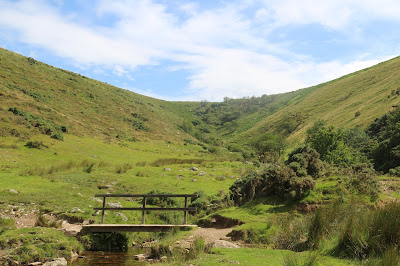 |
| The map reference for our start and end point in the Meldon Reservoir car park was 56133 91791. |
 |
| Looking down towards the old railway viaduct near Meldon Quarry. Steep valley fed by many streams? Could be a good spot for a reservoir? |
 |
| Nothing out of the ordinary, just Common Bird's-Foot-Trefoil. But still a very attractive flower. |
 |
| An oak tree with an interesting bole down by the river. This woodland is a remnant of what used to cover large parts of the moor a long time ago. |
 |
| Slogging our way up the side of Yes Tor. It actually looks steeper than it was in practice but still good exercise. |
 |
| Looking back up to Black Tor, the third 'peak' we visited on our walk. In fact, a good day for 'tor bagging' - Yes Tor, High Willhayes and Black Tor. |
 |
| It's a good year for Rowan (Mountain Ash). Apparently the berries make a good jelly. |
 |
| Looking up a coombe. There is a path picking its way up the stream to the ridge but we took the one which came in from the right. |
 |
| My mushroom guide tells me that this is Panaeolus semiovatus or the Egghead Mottlegill mushroom. Non-psychoactive and non-poisonous. Apparently it is edible but hardly a mouthful for gourmets. |
 |
| Local eccentrics on the top of High Willhayes. OK, so you reached the cairn but there's no need to show off. |
 |
| Breathes there the man with soul so dead , who never to himself hath said . This is my own, my native land. (Sir Walter Scott). |





No comments:
Post a Comment